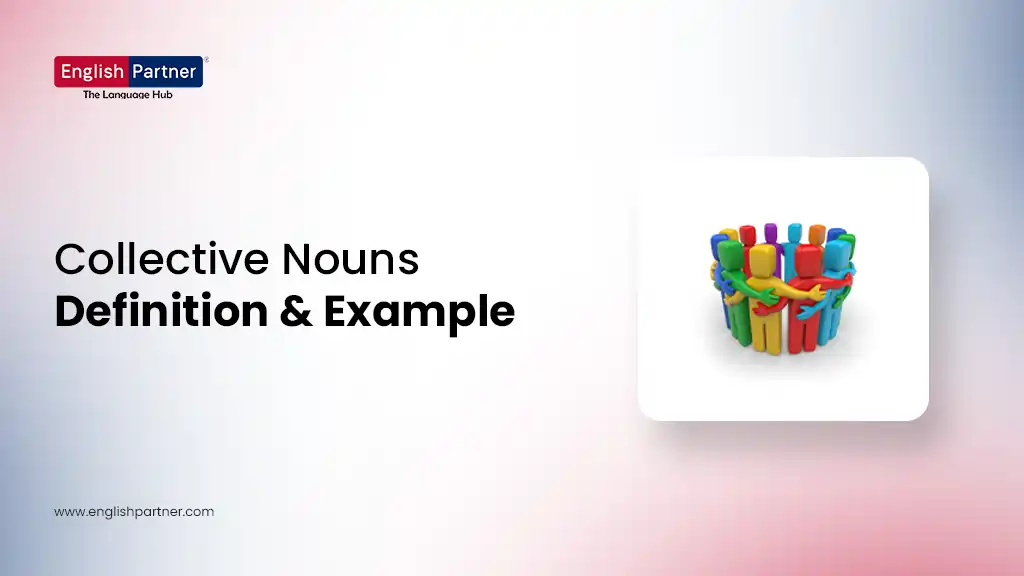
Content Creator
July 28, 2025

Collective Nouns Definition & Example
A flock of —? Sheep
A hive of —? Bees
A panel of —? Judges
What do these words refer to?
Well, these words are known as collective nouns.
Now, let us know how collective nouns improve communication. Also, let’s learn about common mistakes in them.
Collective nouns are sets of words that refer to a group. In general, they refer to groups of common nouns like animals, people, or things.
Now, you can notice the words like herd, choir, team and suite. These words denote a group of animals, people and things.
Don’t you feel repetitive when you use “some,” “few,” and “many” interchangeably to describe a group?
To avoid the loop we incorporate Collective Nouns.
Collective nouns make our conversation efficient and crisp. Using collective nouns make our communication more effective and concise.
A class of students
A board of directors
A tribe of people
A party of friends
A pack of thieves
A dynasty of kings
A staff of officials
A faculty of teachers
A bevy of ladies
A panel of experts
A gang of prisoners.
Err..! That’s more to remember. It is a fact that even the native speakers are not familiar with a lot of collective nouns. I, here, open up a tip for you, here are a few collective nouns you can use to represent a group of people.
1.Team
“Team” – represents a group of people working together.
For example: The football team won the championship
2.Crew
“Crew” – represents a group of people working on ships or aircraft.
For Example: A crew of sailors reached the shore.
3.Jury
“Jury” – represents a group of people decide a verdict in a court case
For Example: The jury of judges disagreed on the verdict.
4.Band
“Band” represents a group of musicians performing together.
For example: The rock band played a great concert.
5.Gang
“Gang” represents a group of people involved in crime.
For Example: A Gang of thieves was punished.
1.Pack / herd / pride – Mammals
For example:
A pack of dogs- A pack of dogs rounded at the street.
A herd of elephants – A herd of elephants moved south in search of water.
2.Flock / gaggle – Birds
For example:
A flock of crows- The flock of crows was feeding on breadcrumbs at the park.
A gaggle of geese– A gaggle of geese was swimming in the pond.
3.Swarm / colony- Insects
For example:
A swarm of mosquitoes – a swarm of mosquitos is unbearable in the hot summer.
A colony of ants – A Colony of ants is busy building a nest.
A line of cars
A cluster of stars
A bunch of keys
A fleet of ships
A shower of rain
A book of exercise
A set of tools
A heap of sand
Common ways to address collective nouns in things
1.Bunch – Small loosely organised group of objects like flowers and fruits.
For example:
A bunch of roses – I received a bunch of roses for my birthday.
A bunch of grapes – I ate a bunch of grapes.
2.Collection – A group of similar objects.
For example:
A collection of stamps – He has a collection of stamps.
A collection of books – Varun’s collection of comic books are worth reading.
3.Series – To represent group things that are together.
For example:
A series of novels – The author wrote a series of crime novels.
A series of smartphones – Blueberry released a series of smartphones that is a complete failure.

Singular: When the collective noun is used to refer to the group as a whole, it takes a singular verb.
For example: The team is playing well.
Plural: Collective nouns can be plural if you are talking about more than one group.
For example: The teams are arguing about strategy.
Incorrect Verb Agreement: One of the most common mistakes is using the wrong verb form. Collective nouns can be singular or plural. It depends on whether you’re referring to one group or many.
Inconsistent Pronoun Usage: Another mistake is using inconsistent pronouns. If you use a singular collective noun, you should use a singular pronoun. If you use a plural collective noun, you should use a plural pronoun.
1.Identify the collective noun in each sentence:
Answers:
2. Choose the correct verb form to complete the sentence:
Answer:
Yashik is a dynamic content creator and persuasive copywriter who blends creativity with strategy. With a strong focus on audience engagement and digital impact, he crafts content that builds trust, drives traffic, and delivers results.

Copyright © 2025 EnglishPartner . All rights reserved